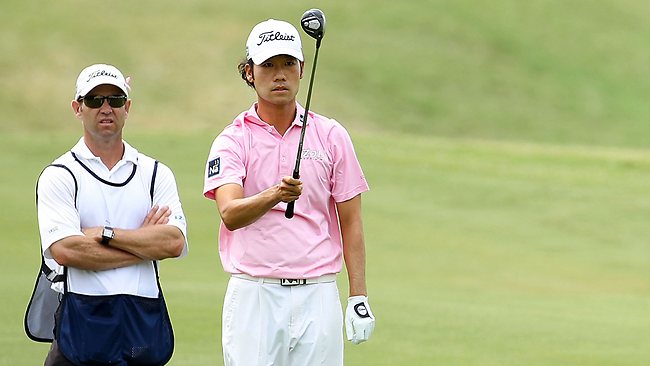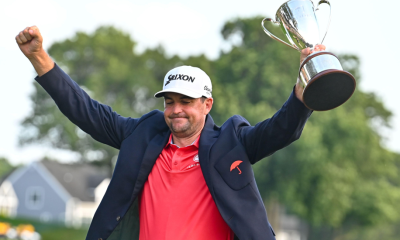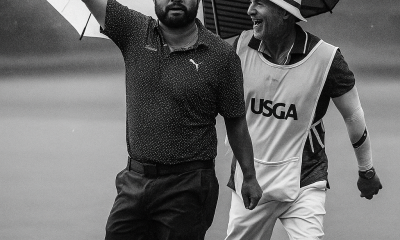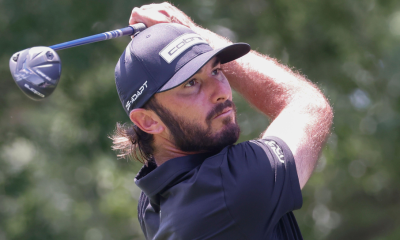Opinion & Analysis
Na, not yet

There are several factors out of a professional golfer’s control in a tournament. They can’t do much to impact the weather, course conditions or the performances of their competitors. Kevin Na had another variable to add to the list of things that were out of his control in the final round of The Players Championship. Na didn’t have total control of himself.
Na’s preshot routine, a collection of half-waggles and full waggles that he performs in pairs before he is able to hit a shot, took an inordinate amount of time on many occasions on Sunday. Many fans snickered, some mocked him, others turned away – but everyone in the gallery felt uncomfortable during his pre-shot routine – especially him.
Imagine Na’s attempt to sleep before the final round. Yes, he’d won a PGA Tour Fall Series event last year, but this was new territory for the 28-year-old. He was in a position to win the world’s fifth biggest golf tournament, and for Christ’s sake, he couldn’t take the club back.
Na predictably stumbled in the final round, finishing in a tie for seventh place, five shots off the lead. His final-round 76 wasn’t a total collapse though – he was in contention until the 13th hole, when he pulled his iron shot in the water to the left of the green on the difficult par 3.
Na had to be exhausted when he finished his 72nd hole at Pete Dye’s masterpiece. For four days, he battled an impossible golf course, the best players in the world and also what proved to be the toughest test, the first six inches of his backswing.
Na said that he was unable to take his club back at the desired time because of a recent swing change. At address, he sets up with more weight on his left side, which feels uncomfortable to him. This explanation makes sense, but based on what I saw on Sunday, I don’t know if that’s the whole story
Na was able to take the club back with little problem on the range at TPC Sawgrass, at least at first. As the warm-up progressed, he seemed to struggle more with the glitch in his takeaway, requiring four waggles instead of the usual two. With longer clubs, he began taking even more waggles – six, then eight, then he’d step back restart.
Na moved through his shots fairly quickly on Nos. 1 through3, playing championship-caliber golf. He extended his lead on those holes over Kuchar by two strokes, and looked as though he was winning the battle against himself in the final round. But when Na reached the tee on No. 5, he began to lose the battle.
Normally, Tour players are grunting at the ball after they hit their tee shots. But Kevin Na was grunting before his ball left the tee. The frustration was evident in his scowled face. Even after backing off twice and several waggles, Na couldn’t start his backswing.
That’s why Na’s tee shot on No. 5 was so impressive. He hit a perfect drive, splitting the bunkers that protect the angled fairway. But a golfer can only grind for so long before it starts to take a toll on them. After missing the green with a hybrid, Na flubbed his chip and made bogey. Then he three-putted No. 6 for back-to-back bogeys. His energy reserves appeared to be depleting.
Na’s inability to pull the trigger wasn’t the only thing that was odd about his pre-shot routine. On Nos. 5 and 6, he backed off the ball before he hit his putts. I doubt his new setup over his full shots had anything to do with that.
“It is what it is,” Na said after the round. “I do need to work on what I need to. I do need to work on my pre-shot routine. I do need to play faster. But the average golfer has no clue how much pressure we’re playing under and how tough it is and how much of a fight for it is mentally. I honestly think with all that going on, I did pretty well fighting.”
Credit should be given to Na for putting up one heck of a fight. On one of golf’s biggest stages, he fought his demons bravely. But it was clear that Na’s problems weren’t entirely limited to a takeaway problem. His entire game and demeanor is full of quirks.
Before Na hit a driver in the final round, he first always stretched his right triceps muscles over his head. Also, like many LPGA Tour players, before he hit his shot he required the ok from his caddie that his alignment was correct, after which his caddie would move off to the side.
On No. 14, Na meticulously tightened his shoelaces, making sure they were perfectly straight before he proceeded with his putting routine — ritualistic, definitely – obsessive compulsive, maybe.
When it was clear that Na had eliminated himself from contention, he began to play faster. He also started to play a little better. But the damage had been done, and the $1.7 million prize was going to belong to someone other than him.
Na was previously known best for being the player that made a 16 at the Texas Open. Now, he will be known as the player that couldn’t pull the trigger at TPC Sawgrass. I hope he overcomes the hiccups that caused him so much grief this week at The Players, because Na has serious game. He hits the ball extremely straight, has a great touch around the greens and is a deft putter.
Na played his heart out this week. It will be a battle for him to get out of his own way, but when he figures it out, he will find himself on top of the leaderboard many times on Saturday night at big tournaments. And in time, he will stay there on Sunday.
Click here for more discussion in the “Tour Talk” forum.
You can follow Zak on Twitter @ZakKoz and GolfWRX on Twitter @GolfWRX
Opinion & Analysis
The 2 primary challenges golf equipment companies face

As the editor-in-chief of this website and an observer of the GolfWRX forums and other online golf equipment discourse for over a decade, I’m pretty well attuned to the grunts and grumbles of a significant portion of the golf equipment purchasing spectrum. And before you accuse me of lording above all in some digital ivory tower, I’d like to offer that I worked at golf courses (public and private) for years prior to picking up my pen, so I’m well-versed in the non-degenerate golf equipment consumers out there. I touched (green)grass (retail)!
Complaints about the ills of and related to the OEMs usually follow some version of: Product cycles are too short for real innovation, tour equipment isn’t the same as retail (which is largely not true, by the way), too much is invested in marketing and not enough in R&D, top staffer X hasn’t even put the new driver in play, so it’s obviously not superior to the previous generation, prices are too high, and on and on.
Without digging into the merits of any of these claims, which I believe are mostly red herrings, I’d like to bring into view of our rangefinder what I believe to be the two primary difficulties golf equipment companies face.
One: As Terry Koehler, back when he was the CEO of Ben Hogan, told me at the time of the Ft Worth irons launch, if you can’t regularly hit the golf ball in a coin-sized area in the middle of the face, there’s not a ton that iron technology can do for you. Now, this is less true now with respect to irons than when he said it, and is less and less true by degrees as the clubs get larger (utilities, fairways, hybrids, drivers), but there remains a great deal of golf equipment truth in that statement. Think about it — which is to say, in TL;DR fashion, get lessons from a qualified instructor who will teach you about the fundamentals of repeatable impact and how the golf swing works, not just offer band-aid fixes. If you can’t repeatably deliver the golf club to the golf ball in something resembling the manner it was designed for, how can you expect to be getting the most out of the club — put another way, the maximum value from your investment?
Similarly, game improvement equipment can only improve your game if you game it. In other words, get fit for the clubs you ought to be playing rather than filling the bag with the ones you wish you could hit or used to be able to hit. Of course, don’t do this if you don’t care about performance and just want to hit a forged blade while playing off an 18 handicap. That’s absolutely fine. There were plenty of members in clubs back in the day playing Hogan Apex or Mizuno MP-32 irons who had no business doing so from a ballstriking standpoint, but they enjoyed their look, feel, and complementary qualities to their Gatsby hats and cashmere sweaters. Do what brings you a measure of joy in this maddening game.
Now, the second issue. This is not a plea for non-conforming equipment; rather, it is a statement of fact. USGA/R&A limits on every facet of golf equipment are detrimental to golf equipment manufacturers. Sure, you know this, but do you think about it as it applies to almost every element of equipment? A 500cc driver would be inherently more forgiving than a 460cc, as one with a COR measurement in excess of 0.83. 50-inch shafts. Box grooves. And on and on.
Would fewer regulations be objectively bad for the game? Would this erode its soul? Fortunately, that’s beside the point of this exercise, which is merely to point out the facts. The fact, in this case, is that equipment restrictions and regulations are the slaughterbench of an abundance of innovation in the golf equipment space. Is this for the best? Well, now I’ve asked the question twice and might as well give a partial response, I guess my answer to that would be, “It depends on what type of golf you’re playing and who you’re playing it with.”
For my part, I don’t mind embarrassing myself with vintage blades and persimmons chasing after the quasi-spiritual elevation of a well-struck shot, but that’s just me. Plenty of folks don’t give a damn if their grooves are conforming. Plenty of folks think the folks in Liberty Corner ought to add a prison to the museum for such offences. And those are just a few of the considerations for the amateur game — which doesn’t get inside the gallery ropes of the pro game…
Different strokes in the game of golf, in my humble opinion.
Anyway, I believe equipment company engineers are genuinely trying to build better equipment year over year. The marketing departments are trying to find ways to make this equipment appeal to the broadest segment of the golf market possible. All of this against (1) the backdrop of — at least for now — firm product cycles. And golfers who, with their ~15 average handicap (men), for the most part, are not striping the golf ball like Tiger in his prime and seem to have less and less time year over year to practice and improve. (2) Regulations that massively restrict what they’re able to do…
That’s the landscape as I see it and the real headwinds for golf equipment companies. No doubt, there’s more I haven’t considered, but I think the previous is a better — and better faith — point of departure when formulating any serious commentary on the golf equipment world than some of the more cynical and conspiratorial takes I hear.
Agree? Disagree? Think I’m worthy of an Adam Hadwin-esque security guard tackle? Let me know in the comments.
@golfoncbs The infamous Adam Hadwin tackle ? #golf #fyp #canada #pgatour #adamhadwin ? Ghibli-style nostalgic waltz – MaSssuguMusic
Podcasts
Fore Love of Golf: Introducing a new club concept

Episode #16 brings us Cliff McKinney. Cliff is the founder of Old Charlie Golf Club, a new club, and concept, to be built in the Florida panhandle. The model is quite interesting and aims to make great, private golf more affordable. We hope you enjoy the show!
Opinion & Analysis
On Scottie Scheffler wondering ‘What’s the point of winning?’

Last week, I came across a reel from BBC Sport on Instagram featuring Scottie Scheffler speaking to the media ahead of The Open at Royal Portrush. In it, he shared that he often wonders what the point is of wanting to win tournaments so badly — especially when he knows, deep down, that it doesn’t lead to a truly fulfilling life.
View this post on Instagram
“Is it great to be able to win tournaments and to accomplish the things I have in the game of golf? Yeah, it brings tears to my eyes just to think about it because I’ve literally worked my entire life to be good at this sport,” Scheffler said. “To have that kind of sense of accomplishment, I think, is a pretty cool feeling. To get to live out your dreams is very special, but at the end of the day, I’m not out here to inspire the next generation of golfers. I’m not out here to inspire someone to be the best player in the world, because what’s the point?”
Ironically — or perhaps perfectly — he went on to win the claret jug.
That question — what’s the point of winning? — cuts straight to the heart of the human journey.
As someone who’s spent over two decades in the trenches of professional golf, and in deep study of the mental, emotional, and spiritual dimensions of the game, I see Scottie’s inner conflict as a sign of soul evolution in motion.
I came to golf late. I wasn’t a junior standout or college All-American. At 27, I left a steady corporate job to see if I could be on the PGA Tour starting as a 14-handicap, average-length hitter. Over the years, my journey has been defined less by trophies and more by the relentless effort to navigate the deeply inequitable and gated system of professional golf — an effort that ultimately turned inward and helped me evolve as both a golfer and a person.
One perspective that helped me make sense of this inner dissonance around competition and our culture’s tendency to overvalue winning is the idea of soul evolution.
The University of Virginia’s Division of Perceptual Studies has done extensive research on reincarnation, and Netflix’s Surviving Death (Episode 6) explores the topic, too. Whether you take it literally or metaphorically, the idea that we’re on a long arc of growth — from beginner to sage elder — offers a profound perspective.
If you accept the premise literally, then terms like “young soul” and “old soul” start to hold meaning. However, even if we set the word “soul” aside, it’s easy to see that different levels of life experience produce different worldviews.
Newer souls — or people in earlier stages of their development — may be curious and kind but still lack discernment or depth. There is a naivety, and they don’t yet question as deeply, tending to see things in black and white, partly because certainty feels safer than confronting the unknown.
As we gain more experience, we begin to experiment. We test limits. We chase extreme external goals — sometimes at the expense of health, relationships, or inner peace — still operating from hunger, ambition, and the fragility of the ego.
It’s a necessary stage, but often a turbulent and unfulfilling one.
David Duval fell off the map after reaching World No. 1. Bubba Watson had his own “Is this it?” moment with his caddie, Ted Scott, after winning the Masters.
In Aaron Rodgers: Enigma, reflecting on his 2011 Super Bowl win, Rodgers said:
“Now I’ve accomplished the only thing that I really, really wanted to do in my life. Now what? I was like, ‘Did I aim at the wrong thing? Did I spend too much time thinking about stuff that ultimately doesn’t give you true happiness?’”
Jim Carrey once said, “I think everybody should get rich and famous and do everything they ever dreamed of so they can see that it’s not the answer.”
Eventually, though, something shifts.
We begin to see in shades of gray. Winning, dominating, accumulating—these pursuits lose their shine. The rewards feel more fleeting. Living in a constant state of fight-or-flight makes us feel alive, yes, but not happy and joyful.
Compassion begins to replace ambition. Love, presence, and gratitude become more fulfilling than status, profits, or trophies. We crave balance over burnout. Collaboration over competition. Meaning over metrics.
Interestingly, if we zoom out, we can apply this same model to nations and cultures. Countries, like people, have a collective “soul stage” made up of the individuals within them.
Take the United States, for example. I’d place it as a mid-level soul: highly competitive and deeply driven, but still learning emotional maturity. Still uncomfortable with nuance. Still believing that more is always better. Despite its global wins, the U.S. currently ranks just 23rd in happiness (as of 2025). You might liken it to a gifted teenager—bold, eager, and ambitious, but angsty and still figuring out how to live well and in balance. As much as a parent wants to protect their child, sometimes the child has to make their own mistakes to truly grow.
So when Scottie Scheffler wonders what the point of winning is, I don’t see someone losing strength.
I see someone evolving.
He’s beginning to look beyond the leaderboard. Beyond metrics of success that carry a lower vibration. And yet, in a poetic twist, Scheffler did go on to win The Open. But that only reinforces the point: even at the pinnacle, the question remains. And if more of us in the golf and sports world — and in U.S. culture at large — started asking similar questions, we might discover that the more meaningful trophy isn’t about accumulating or beating others at all costs.
It’s about awakening and evolving to something more than winning could ever promise.






















Brian Cass
May 14, 2012 at 2:45 pm
He says this is a weight distribution issue for his full swing….um…he was doing this with his putter as well as I recall. This has more to do with negative thoughts than it does with balance in my opinion.
Feisty
May 14, 2012 at 1:59 pm
I feel for the guy because he is so aware of his issues. I hope they can be fixed, because part of me wonders if he’s just obsessive compulsive and he can’t fix the little twitches. It’s not the end of the world, but I think the hiccups will keep him from making it through a full tournament without cracking. He seems like a good guy, too.